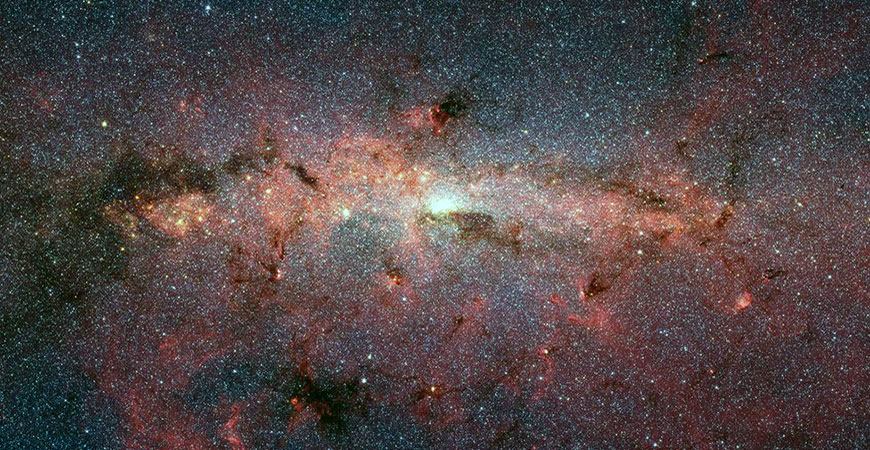
A UC Merced researcher and her teammates around the world have succeeded in measuring the total amount of matter in the universe for the second time.
A new paper in the Astrophysical Journal, titled “Constraining Cosmological Parameters using the Cluster Mass-Richness Relation,” shows that matter makes up 31% of the universe, with the remainder consisting of dark energy — answering one of the most interesting and important questions in cosmology.
“Cosmologists believe that only about 20% of this total matter is made of regular, or ‘baryonic’ matter, which includes stars, galaxies, atoms and life,” said the paper’s lead author, postdoctoral researcher Mohamed Abdullah with the National Research Institute of Astronomy and Geophysics-Egypt, Chiba University-Japan. “About 80% is made of dark matter, whose mysterious nature is not yet known but may consist of some as-yet-undiscovered subatomic particle.”
The team measured the number of galaxy members to determine the mass of galaxy clusters to arrive at the conclusion.
 “This is a well-proven technique for determining the total amount of matter in the universe — comparing the observed number and mass of galaxy clusters per unit volume with predictions from numerical simulations,” said coauthor Vice Chancellor for Research, Innovation and Economic Development Gillian Wilson. She is Abdullah’s former graduate advisor and a physics professor at UC Merced.
“This is a well-proven technique for determining the total amount of matter in the universe — comparing the observed number and mass of galaxy clusters per unit volume with predictions from numerical simulations,” said coauthor Vice Chancellor for Research, Innovation and Economic Development Gillian Wilson. She is Abdullah’s former graduate advisor and a physics professor at UC Merced.
“Because present-day galaxy clusters have formed from matter that has collapsed over billions of years under its own gravity, the number of clusters observed at the present time, the so-called ‘cluster abundance,’ is very sensitive to cosmological conditions and, in particular, the total amount of matter,” she said.
A higher percentage of total matter in the universe would result in more clusters being formed, explained coauthor Professor Anatoly Klypin from the University of Virginia.
“But it is difficult to measure the mass of any galaxy cluster accurately because most of the matter is dark so we can’t see it directly with telescopes,” he said.
To overcome this difficulty, the team had to use an indirect tracer of cluster mass. The researchers relied upon the fact that more massive clusters contain more galaxies than less massive clusters. Because galaxies consist of luminous stars, the number of galaxies in each cluster can be used as a way of indirectly determining its total mass. This resourceful and creative technique is known as the “mass-richness relation (MRR).” By measuring the number of galaxies in each cluster in their sample, team members could use the MRR to estimate the total mass of each cluster, explained coauthor Professor Tomoaki Ishiyama from Chibu University.
The researchers compared the observed number and mass of galaxy clusters per unit volume against predictions from numerical simulations. The best-fit match between observations and simulations was to a universe consisting of 31% total matter, a value in agreement with that obtained using cosmic microwave background (CMB) observations from the Planck satellite.
Planck was a European Space Agency satellite that measured the CMB — the residual radiation left over from the big bang, at a much greater sensitivity and resolution than previously known.
CMB is a completely independent technique, considered to be the gold standard for constraining cosmological parameters such as the total matter in the universe.
The study was supported by funding from the National Science Foundation, NASA and Japan Society for the Promotion of Science, and is the first measurement of matter density using the MRR. The results agree with and build on the team’s previous work using the cluster galaxy orbit technique. The results also show that cluster abundance is a competitive technique for constraining cosmological parameters, and complements noncluster techniques such as CMB anisotropies, baryon acoustic oscillations, Type Ia supernovae or gravitational lensing.
“The paper not only demonstrates that the MRR technique is a powerful tool for determining cosmological parameters,” Wilson said, “but explains how the MRR technique can be applied to new datasets becoming available from large wide and deep-field imaging and spectroscopic galaxy surveys such as the Dark Energy Survey, Dark Energy Spectroscopic Instrument, Euclid Telescope, eROSITA Telescope and James Webb Space Telescope.”
The team credits its achievement to being the first to successfully utilize spectroscopy, the technique of separating radiation into a spectrum of individual bands, or colors.
Spectroscopy allowed the researchers to precisely determine both the distance to each cluster and which of the galaxies are true members, gravitationally bound to the cluster, rather than background or foreground interlopers along the line of sight.
Previous studies that attempted to use MRR relied on pictures of the sky taken at a small number of different wavelengths to determine the distance to each cluster and which galaxies seen nearby were true galaxy members.
The team used observations from the Sloan Digital Sky Survey (SDSS) to create “GalWeight,” a publicly available catalog of galaxy clusters, then compared the number of clusters in the catalog with simulations to determine the total matter.
“Like Goldilocks, we found the answer that was ‘just right,’” Abdullah said.

Senior Writer and Public Information Representative
Office: (209) 228-4406
Mobile: (209) 201-6255